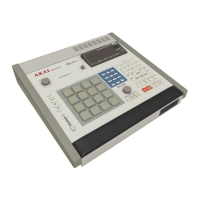138
• The
FADEOUT(MSECS) field:
This field sets the amount of time over which the sound fades down to
silence at its end, measured in milliseconds. This is different than common
"initial decay" or "release" envelope parameters since the decay will always
end exactly at the end of the sample, this setting actually sets the position
within the sound at which the decay will begin. This field is identical to the
field of the same name in the
SAMPLE NEW SOUND screen.
• The
VEL>START(MS) field:
This field allows the incoming note velocity to modulate the start address of
the sound. This is very useful for simulating dynamics on drums because a
drum sound played from a position after its start sounds very much like the
same drum played softly. The contents of this field sets the maximum time
(in milliseconds) which will be added to the contents of the
START field. If
the incoming velocity is 1, the entire contents of this field is added to the
START field, causing the sound to start playing from a position after its
initial attack; if the incoming velocity is 127, nothing is added to the
START
field, causing a faster attack time; and for velocities between l and 127, a
proportional amount of the contents of this field is added to the
START
field.
• The
VEL>ATTACK(MS) field:
This field allows the incoming note velocity to modulate the attack time of
the sound. This is very useful for simulating dynamics on drums because a
drum sound played with a soft attack time sounds very much like the same
drum played softly. The contents of the field sets the maximum time (in
milliseconds) which will be added to the
ATTACK field. If the incoming
velocity is 1, the entire contents of this field is added to the
ATTACK field,
causing a slower attack time; if the incoming velocity is 127, nothing is added
to the
ATTACK field, causing a faster attack time; and for velocities between
1 and 127, a proportional amount of the contents of this field is added to the
ATTACK field.
NOTE: The ATTACK, FADEOUT, VEL>START, and VEL>ATTACK
fields have maximum values which depend on the value of the sample
length and the values set in the other fields.
• The
VEL>VOL(0-100) field:
This field allows the incoming note velocity to modulate the volume level of
the sound.
A maximum setting of 100 is normal and produces full control
of volume by the incoming note velocity setting. At the other extreme, a
setting of 0 will cause the drum to play at full volume regardless of the note
velocity.
NOTE: All of the parameters in the EDIT A SOUND screens are
saved with the individual sound file except the
DOUBLE PLAY
parameters, which are saved within SET files.

